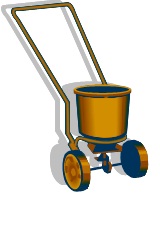 Nitrogen Fertilizers in the Landscape - September 19, 2012 Jeff Schalau, Agent, Agriculture & Natural Resources University of Arizona Cooperative Extension, Yavapai County Nitrogen is almost always the most limiting plant nutrient in natural ecosystems. Limited nitrogen availability is Mother Nature’s way of maintaining plant growth rates which are in balance with site resources and environmental conditions such as temperature, growing season, soil moisture and availability of other essential plant nutrients. Some popular gardening gurus profess that we should fertilize or “feed” our landscapes with nitrogen containing fertilizers several times per year. I hope after reading this column, you will see that increased fertilization does not always lead to healthier, more sustainable landscapes. While regular applications of nitrogen fertilizer will speed growth rates of native and non-native ornamentals, regularly fertilized plants also have weaker tissue (wood), require more frequent maintenance (pruning and shearing), and the these plants will be more attractive to herbivores (insects and other animals). In addition, frequent pruning and shearing of plants creates entry points for plant diseases to become established and each wound will require additional plant resources to form callous tissue and aid in the recovery process. Before we go any further, let’s clarify situations which justify regular nitrogen fertilization. Fruit and nut crops, vegetable gardens, annual/perennial flowers, pastures, turf (lawns), roses, and other flowering plants will perform better with appropriately selected and applied fertilizer (most of these contain nitrogen). The added nitrogen replaces what these more demanding plants remove from the soil and require to successfully produce the desired crop. With landscape trees and shrubs (including cacti and succulents), nitrogen fertilizer is usually unnecessary and should be used only after observation of deficiency symptoms. Nitrogen deficiency symptoms are poor growth, yellowing of older leaves, and sparse foliage. If nitrogen deficiency is suspected, apply a modest amount of nitrogen-containing fertilizer during the growing season. Fertilizer applications should be placed where plant roots are present. This is often near the drip line (vertical projection of the canopy to the soil surface). Fertilizer applications should be followed by irrigation to carry the fertilizer to the root zone. Inorganic nitrogen fertilizer is more easily leached from the root zone with irrigation or precipitation. Once it is below the root zone, it is unavailable to the plant. The leached nitrogen can then enter ground water supplies or watercourses causing negative environmental impacts. Light fertilization or use of organic nitrogen fertilizers will minimize leaching and therefore lessen environmental impacts. Nitrogen deficiency symptoms should improve within a few weeks of the fertilizer application. Iron deficiency is fairly common in the southwest. Iron is less available under alkaline soil conditions – which are common on soils derived from limestone. Symptoms of iron deficiency are yellowing of new leaves. When iron availability is severely limited, new leaves often have green veins with yellow or white in between the veins (interveinal chlorosis). Older leaves will often appear normal. The easiest way to correct iron deficiency is to apply a foliar spray of chelated iron. Symptoms should improve within two weeks of the spray application. Cool soil temperatures in early spring can also exacerbate iron deficiency symptoms. In my experience, phosphorus and potassium symptoms are not common in landscape trees and shrubs. Let’s be clear: fertilizer is not "plant food." Plants produce their own food in the form of sugars through photosynthesis. The nutrients supplied by fertilizers increase raw materials available for photosynthesis and growth of plants which may or may not be necessary. In my opinion, using the term “plant food” to describe fertilizer makes it sound absolutely necessary and implies that if you forgot to “feed” the plant, it would die of starvation. Of course, this is a myth. Many times plant problems are caused by poorly adapted varieties, poor planting, inadequate soil drainage, compaction, or improper irrigation practices. All of these factors influence the root system which will directly affect growth and vigor. Fertilization will not correct these problems and, in some cases, can hasten the decline of a plant. Remember to carefully evaluate whether or not you need to fertilize your landscape ornamentals. Natives and drought tolerant species usually will not typically require fertilization. Plants that originate in more humid environments often prefer acid soils. Since it is nearly impossible to create acid soil conditions, these plants will likely display nutrient deficiencies and are more likely to respond to fertilizers. For healthy landscapes, use locally-adapted plants and fertilize only when necessary for the crop being grown. Follow the Backyard Gardener on Twitter – use the link on the BYG website. If you have other gardening questions, call the Master Gardener help line in the Camp Verde office at 928-554-8999 Ext. 3 or e-mail us at cottonwoodmg@yahoo.com and be sure to include your name, address and phone number. Find past Backyard Gardener columns or provide feedback at the Backyard Gardener web site: http://cals.arizona.edu/yavapai/anr/hort/byg/. |